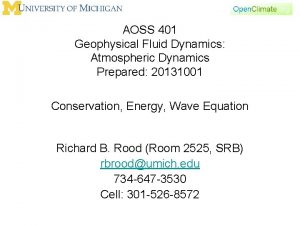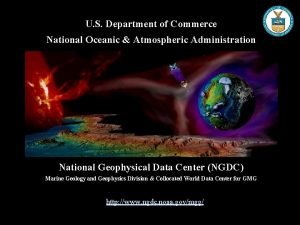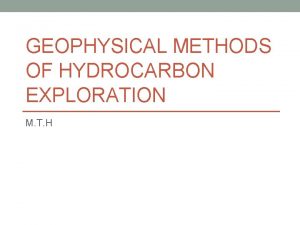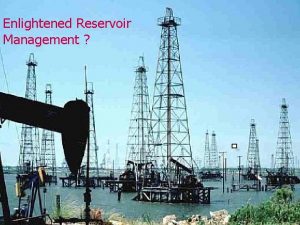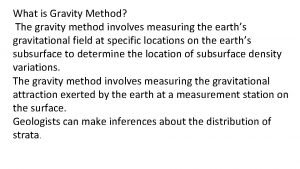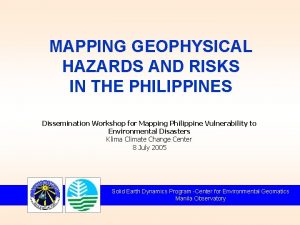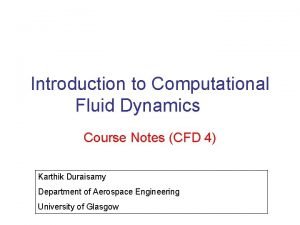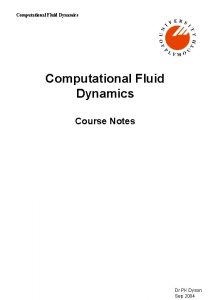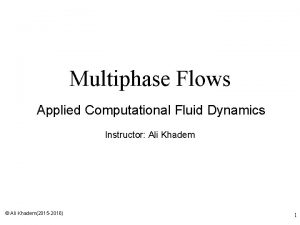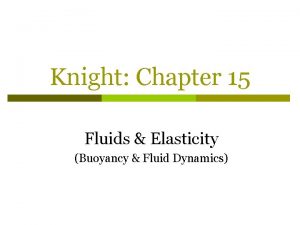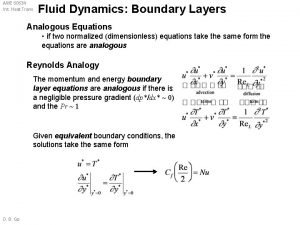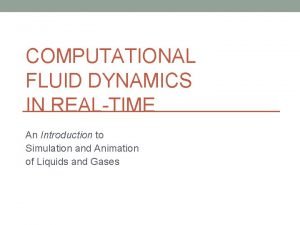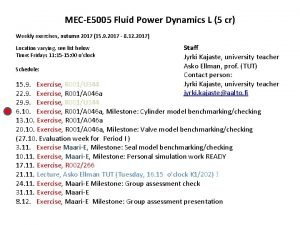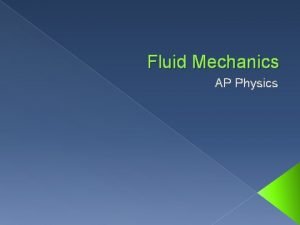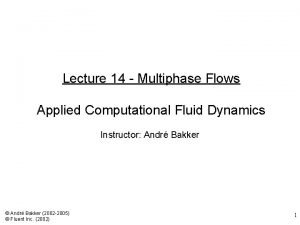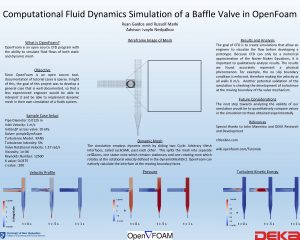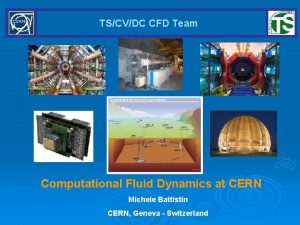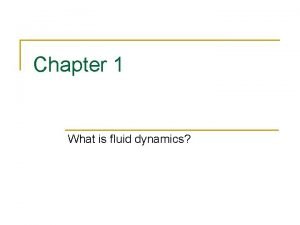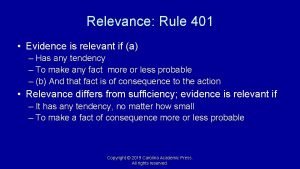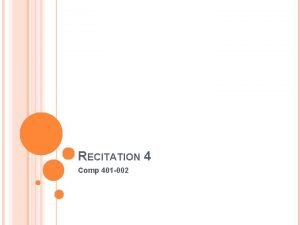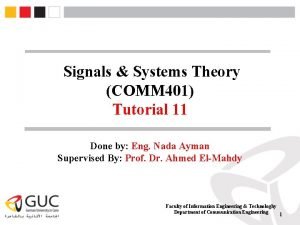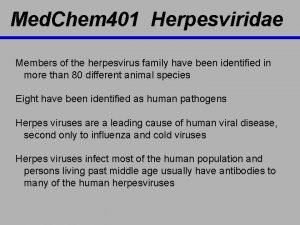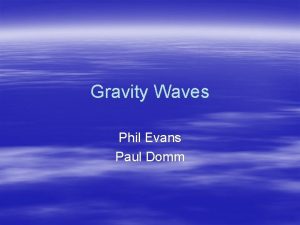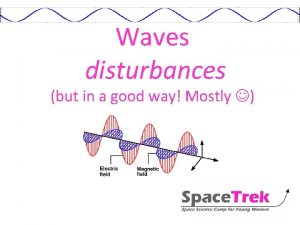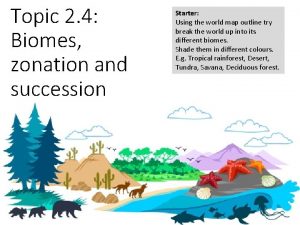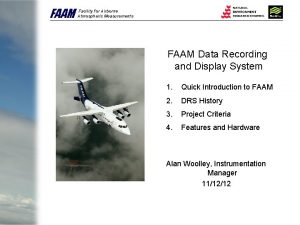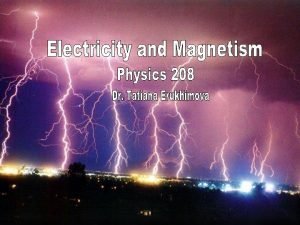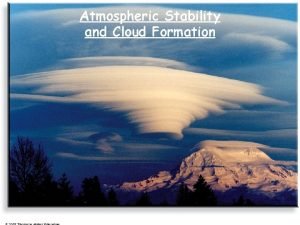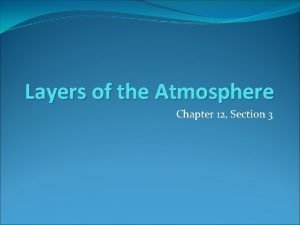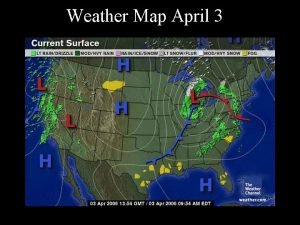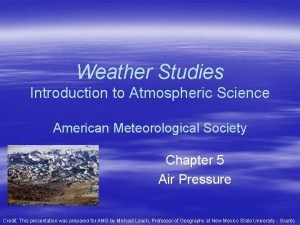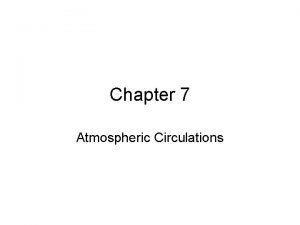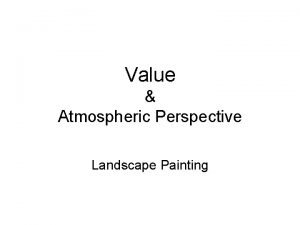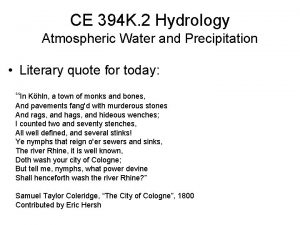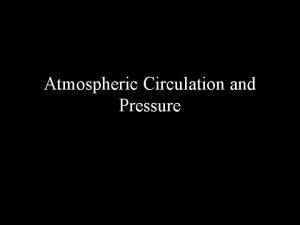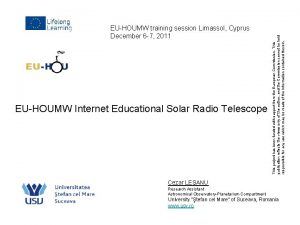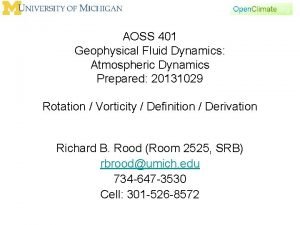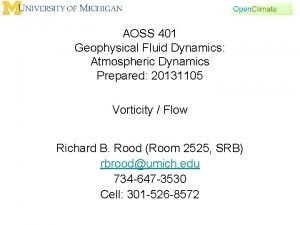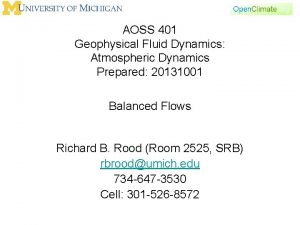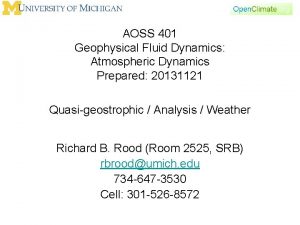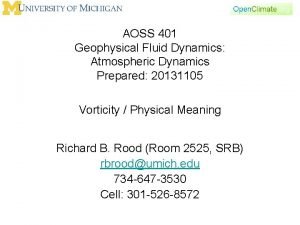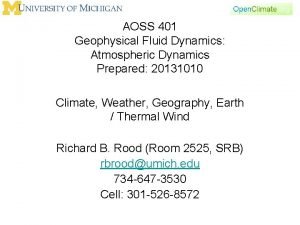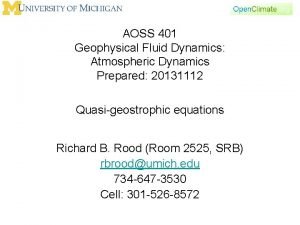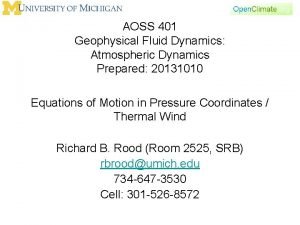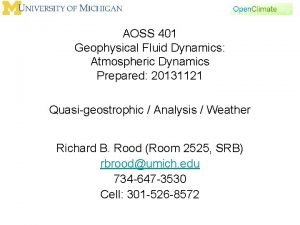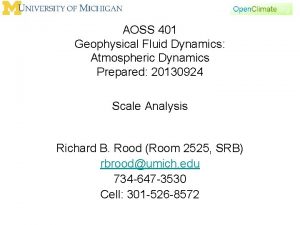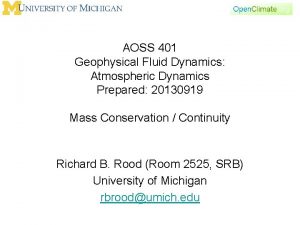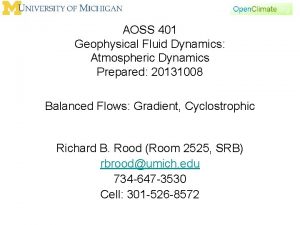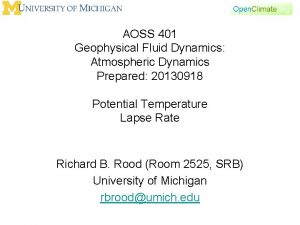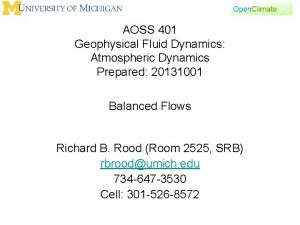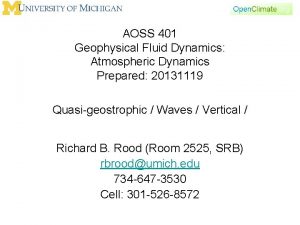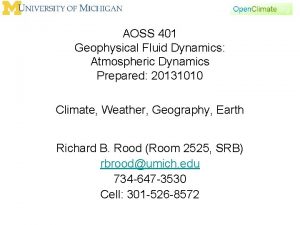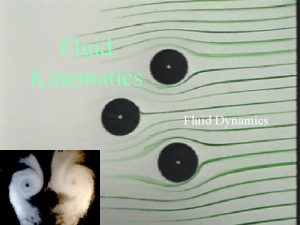AOSS 401 Geophysical Fluid Dynamics Atmospheric Dynamics Prepared



















































































- Slides: 83

AOSS 401 Geophysical Fluid Dynamics: Atmospheric Dynamics Prepared: 20131105 Vorticity / Flow Richard B. Rood (Room 2525, SRB) rbrood@umich. edu 734 -647 -3530 Cell: 301 -526 -8572

Class News • Ctools site (AOSS 401 001 F 13) • Second Examination on December 10, 2013 • Homework – Posted on Ctools / Due on Thursday 11/7/13

Weather • National Weather Service – Model forecasts: • Weather Underground – Model forecasts: • NCAR Research Applications Program

Outline • Vorticity and Flow

Vorticity Equation DIVERGENCE TILTING SOLENOIDAL or BAROCLINIC Changes in relative vorticity are caused by: • Divergence • Tilting • Gradients in density on a pressure surface • Advection

Scale Analysis of the Vorticity Equation Changes in relative vorticity are caused by: – Divergence – Tilting – Gradients in density – Advection Which of these are most important for largescale flows? Back to scale analysis…

Scale factors for “large-scale” mid-latitude

Terms in Vorticity Equation Time rate of change Horizontal advection Vertical advection Divergence Tilting Planetary vorticity advection Solenoidal term

Assume balance among terms of 10 -10 s-2

Two important definitions • barotropic – density depends only on pressure. And by the ideal gas equation, surfaces of constant pressure, are surfaces of constant density, are surfaces of constant temperature. • baroclinic – density depends on pressure and temperature.

Barotropic Potential Vorticity • We can learn a lot about the atmosphere by considering the barotropic potential vorticity

Barotropic Potential Vorticity Assume constant density Integrate with height, z 1 z 2 over a layer of depth H.

Remember the Thermal Wind? p is an independent variable, a coordinate. Hence, x and y derivatives are taken with p constant.

Implications of Thermal Wind for a Barotropic Fluid… • Barotropic: temperature is constant on a pressure surface • This means • Geostrophic wind is constant with height in pressure coordinates in a barotropic fluid

Barotropic Potential Vorticity

What happens if the depth (H) is constant? • Conservation of potential vorticity becomes conservation of absolute vorticity…

Barotropic Potential Vorticity Potential vorticity is a measure of absolute vorticity relative to the depth of the vortex. What happens if the depth (H) changes?

Relative vorticity with change of depth

The vortex went over the mountain Surface with a hill.

Vorticity and depth • There is a relationship between depth and vorticity. • As the depth of the vortex changes, the relative vorticity has to change in order to conserve the potential vorticity. • We have now linked the rotational and irrotational components of the wind. – divergence and curl – vorticity and divergence • Potential vorticity indicates an interplay between relative and planetary vorticity through conservation of absolute angular momentum.

Let’s explicitly map these ideas to the Earth

Local vertical / planetary vorticity

relative vorticity/planetary vorticity relative vorticity planetary vorticity

Compare relative vorticity to planetary vorticity for large-scale and middle latitudes planetary vorticity is usually larger than relative vorticity

Relative and planetary vorticity • Planetary vorticity is cyclonic is positive vorticity • Planetary vorticity, in middle latitudes, is usually larger than relative vorticity • A growing cyclone “adds to” the planetary vorticity. – Lows are intense • A growing anticyclone “opposes” the planetary vorticity. – Highs are less intense

Compare relative vorticity to planetary vorticity and to divergence Flow is rotationally dominated, but divergence is crucial to understanding the flow.

Return to our simple form of potential vorticity From scaled equation, with assumption of constant density.

Fluid of changing depth • Stretching and shrinking of a column will change the relative vorticity.

Application to flow on the Earth

What might cause this wave-like flow?

Flow over a mountain Mountain

Use our simple form of potential vorticity From scaled equation, with assumption of constant density and temperature.

Flow over a mountain (long in the north-south) (can’t go around the mountain) west east

Depth, H Flow over a mountain Mountain west east

Flow over a mountain (assume flow is adiabatic) Depth, H θ + Δθ θ Mountain west east

Flow over a mountain (far upstream constant zonal flow) Depth, H θ + Δθ ζ=0 θ Mountain west east

Use the barotropic potential vorticity equation From scaled equation, with assumption of constant density and temperature.

What happens as air gets to mountain? Depth, H θ + Δθ ζ=0 θ Mountain west east

What happens as air gets to mountain? Air is lifted. Lifting higher at ground than upper air. (pressure gradient force spreads it out) Depth, H θ + Δθ ζ=0 θ Mountain west east

What happens as air gets to mountain? ζ=0 θ Depth, H +ΔH θ + Δθ Air is lifted. Lifting higher at ground than upper air. (pressure gradient force spreads it out) Mountain west east

What happens as air gets to mountain? θ Depth, H +ΔH θ + Δθ Air is lifted. Lifting higher at ground than upper air. (pressure gradient force spreads it out) ζ must increase Mountain west east

What does it mean for the relative vorticity to increase?

What happens in these waves? Loses cyclonic vorticity Same as gains anticyclonic vorticity Gains cyclonic vorticity

Or schematically Rotational Shear Cyclonic Anticyclonic

What happens as air gets to mountain? Air turns cyclonically to increase vorticity. In northern hemisphere turns north. θ Depth, H +ΔH θ + Δθ ζ must increase Mountain west east

Depth, H +ΔH In the (east-west, north-south) plane MOUNTAINS n s west east

What happens as air goes over mountain? Air turns anti-cyclonically to decrease vorticity. In northern hemisphere turns south. Depth, H -ΔH θ + Δθ ζ must decrease θ Mountain west east

MOUNTAINS n Depth, H -ΔH Depth, H +ΔH In the (east-west, north-south) plane s west east

What happens as air goes down mountain? Air turns cyclonically to increase vorticity. In northern hemisphere turns north. θ + Δθ Depth, H +ΔH ζ must increase θ Mountain west east

Depth, H +ΔH n Depth, H -ΔH Depth, H +ΔH In the (east-west, north-south) plane s Stretching here causes relative vorticity to increase; northward turning west MOUNTAINS Arrives here with northward momentum “Overshoots” east

What is happening with planetary vorticity? f is greater for deflections to north f is less for deflections to south s west Depth, H +ΔH MOUNTAINS n Depth, H -ΔH Depth, H +ΔH (In the (east-west, north-south) plane) east

What is happening with planetary vorticity? f = f 1 ζ = ζ 1 H = H 1 MOUNTAINS Depth, H +ΔH n Depth, H -ΔH Depth, H +ΔH (In the (east-west, north-south) plane) Has an excess of potential vorticity; relative vorticity must decrease f = f 2 > f 1 ζ = ζ 2 = ζ 1 H = H 2 = H 1 s west east

Excursion into the atmosphere

“Colorado Lows”

What happens if wind is from east? θ + Δθ θ Mountain west east

What is happening with planetary vorticity? s Depth, H +ΔH MOUNTAINS n Depth, H -ΔH Depth, H +ΔH (In the (east-west, north-south) plane) Flow from east: planetary and relative vorticity offset each other; no overshoot or undershoot. west east

Consider the vertical structure more

Where is this flow more barotropic? 10 m/s 30 m/s A, warmer - p, vertical y, north 20 m/s 5 m/s B, cooler

Idealized vertical cross section

Vorticity on Large Scales • Remember, vorticity is caused by – Wind shear – Rotation in the flow • Can we identify these on weather maps? • (The following maps come from http: //www. aos. wisc. edu/weather/)

300 mb Wind Speed

Where is there positive vorticity?

500 mb Vorticity

Thermal Wind • Remember, thermal wind relates – Vertical shear of geostrophic wind – Horizontal temperature gradients • Can we identify these on weather maps?

Where are the strongest ?

850 mb Temperature

Convergence/Divergence • Remember, vertical motion on large scales directly related to – Convergence/divergence of ageostrophic wind – Curvature in the flow • Can we identify these on weather maps?

Where are surface lows/highs?

Surface Precipitation

850 mb Temperature

Concepts • Vorticity: shear and curvature – Why is curvature vorticity (as opposed to shear vorticity) usually associated with developing low pressure systems? • Divergence and convergence and location of surface high and low pressure systems • Thermal wind—vertical shear of the horizontal wind and horizontal temperature gradients

Concepts • Features commonly found together – Jet stream – Upper level positive vorticity – Fronts – Midlatitude cyclones (low pressure systems) • Coincidence? • More on this later…

Mid-latitude cyclones • What we know: – Low pressure systems – Form through spinup of low-level positive vorticity – Divergence/convergence is key • This is just the beginning… – Always closely associated with fronts—why? – Sometimes develop rapidly, sometimes not at all—why?

The mid-latitude cyclone

Mid-latitude cyclones: Norwegian Cyclone Model

Fronts and Precipitation Norwegian Cyclone Model Cloud. Sat Radar

Idealized vertical cross section

Cold and warm advection ld o c warm

Lifting and sinking

Increasing the pressure gradient force

Almost Weather

Mid-latitude cyclones: Norwegian Cyclone Model • http: //www. srh. weather. gov/jetstream/syno ptic/cyclone. htm

Weather • National Weather Service – Model forecasts: • Weather Underground – Model forecasts: • NCAR Research Applications Program
 Geophysical fluid dynamics
Geophysical fluid dynamics National geophysical data center
National geophysical data center Gravity method of geophysical exploration
Gravity method of geophysical exploration Reservoir geophysical corporation
Reservoir geophysical corporation Latitude correction formula
Latitude correction formula Tsunami sa basilan at romblon
Tsunami sa basilan at romblon Body fluid compartments
Body fluid compartments Movement of body fluids
Movement of body fluids Is synovial fluid extracellular fluid
Is synovial fluid extracellular fluid Interstitial fluid vs extracellular fluid
Interstitial fluid vs extracellular fluid Ascitic fluid examination
Ascitic fluid examination P1-p2
P1-p2 Interstitial vs intracellular
Interstitial vs intracellular Fluid statics deals with
Fluid statics deals with Fluid mechanics chapter
Fluid mechanics chapter Ntes cfd
Ntes cfd Fluid dynamics
Fluid dynamics Fluid dynamics
Fluid dynamics Computational fluid dynamics
Computational fluid dynamics Fluid dynamics
Fluid dynamics Sutherland's law
Sutherland's law Fluid dynamics
Fluid dynamics Real-time fluid dynamics for games
Real-time fluid dynamics for games Fluid power dynamics
Fluid power dynamics Euler's equation of motion in fluid mechanics
Euler's equation of motion in fluid mechanics Computational fluid dynamics
Computational fluid dynamics Efdc
Efdc Fluid dynamics
Fluid dynamics Computational fluid dynamics
Computational fluid dynamics Fluid dynamics
Fluid dynamics Computational fluid dynamics
Computational fluid dynamics Fluid dynamics definition
Fluid dynamics definition Clase 401
Clase 401 Nia 930
Nia 930 Melinex polyester film
Melinex polyester film Quantas prendas faltam para a turma 401 empatar com a 402
Quantas prendas faltam para a turma 401 empatar com a 402 401 relevance
401 relevance Ge 401
Ge 401 Ce-401
Ce-401 Multithread chain stitch
Multithread chain stitch 401 branard street houston tx
401 branard street houston tx Lsp401
Lsp401 P-401 faa
P-401 faa Class 600 stitch
Class 600 stitch As riquezas mundanas nada valem pra mim
As riquezas mundanas nada valem pra mim Where should charts with food code 3-401 be displayed
Where should charts with food code 3-401 be displayed Comp 401
Comp 401 Ce-401
Ce-401 Jul 401 english
Jul 401 english Bmb 401
Bmb 401 Svartpilen 401 dyno
Svartpilen 401 dyno Csc 401
Csc 401 Clasa miilor
Clasa miilor Hd-wp-4k-401-c
Hd-wp-4k-401-c Eng m 401
Eng m 401 Bp 401
Bp 401 Rose shawlee
Rose shawlee Ir401 form
Ir401 form Comm 401
Comm 401 Cse401
Cse401 Disadvantages of concurrent engineering
Disadvantages of concurrent engineering Chem 401
Chem 401 Atmospheric distortion correction
Atmospheric distortion correction Forceparcel
Forceparcel Atmospheric opacity
Atmospheric opacity Prediction explanation
Prediction explanation Facility for airborne atmospheric measurements
Facility for airborne atmospheric measurements Dr erukhimova
Dr erukhimova Atmospheric stability
Atmospheric stability The four main layers of the atmosphere
The four main layers of the atmosphere Penn state meteo
Penn state meteo Denture bearing area
Denture bearing area Usairnet temperature map
Usairnet temperature map High pressure area
High pressure area Atmospheric chemistry lecture notes
Atmospheric chemistry lecture notes Weather studies introduction to atmospheric science
Weather studies introduction to atmospheric science What is weather variables
What is weather variables Single cell model of atmospheric circulation
Single cell model of atmospheric circulation Landscape atmospheric perspective
Landscape atmospheric perspective Atmospheric vortex engine
Atmospheric vortex engine Atmospheric refraction
Atmospheric refraction Atmospheric convection
Atmospheric convection Circulates air between 60-90 latitudes
Circulates air between 60-90 latitudes Atmospheric opacity
Atmospheric opacity
